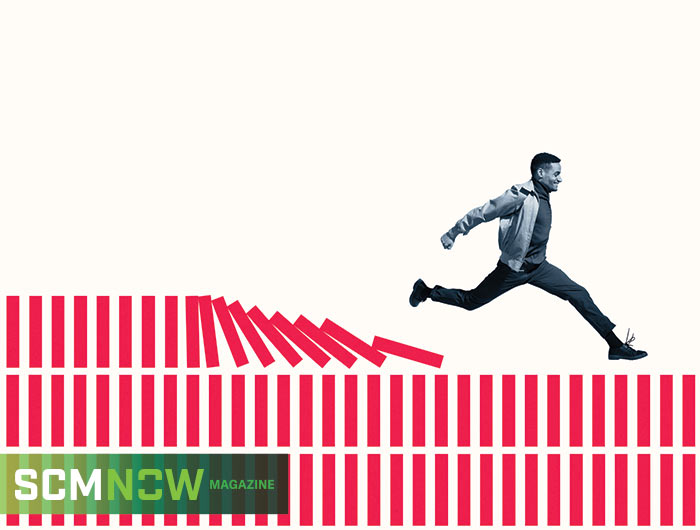Supply chain professionals do the impossible every day. When you stop to think about it, so much is outside of any one organization’s control, and it’s pretty miraculous that systems flow as smoothly as they do. One of the particularly challenging tasks that has been on my mind lately is risk management. Immediate risks may be relatively easy to identify, predict and control; however, the future tends to be a bit hazier. The most difficult risks to predict are knock-on effects further down the supply chain — but they have very real consequences if an organization isn’t ready for them.
What is a knock-on effect?
A knock-on effect is an indirect impact on a given organization caused by a risk event that has direct influence on a related entity. In simple terms, it’s the domino effect. While some knock-on effects may ease within days, others can take weeks or months, depending on how many supply chain links are between the disruptive event and the affected organization.
As an example, think back to the Suez Canal blockage from early 2021. If your company wasn’t expecting a shipment coming through the Suez Canal, you probably went about business as usual. However, had the blockage gone on for longer, all kinds of knock-on effects could have affected your network.
The Suez Canal typically transports about 10% of the global seaborne oil trade — or about 3 million barrels per day. While this amount seems small, the blockage’s impact on crude oil prices quickly became significant. The day after the Ever Given’s accident, crude oil prices jumped about 6% as oil analysts reported that 10 crude tankers with 13 million barrels of oil were influenced.
Crude oil is refined into petroleum products. While these products are most commonly used as fuels and for heating, they also are used to make plastics. Ongoing shortages of crude oil would likely affect transportation costs in the near term, but could also influence the price and availability of plastics in the long term. If a plastics manufacturer has to pay more for the petroleum, or cannot obtain it at all, then the manufacturer is forced to raise its prices or stop fulfilling orders altogether. Soon, manufacturers looking to buy the plastic for a product or packaging may have to pay more or wait longer to get the plastic they need. If there’s a problem with petroleum supply, consumer products such as appliances, furniture and sporting equipment could all ultimately feel the effects — and their manufacturers wouldn’t even know it at first.
In this case, the blockage was resolved in about a week, and crude oil prices quickly dropped too. The scary part is that this very real risk might not have even been on a plastic user’s radar because it is so far down the supply chain.
Similarly, if a hurricane or tsunami affects manufacturing in an isolated region where your company doesn’t happen to have any tier-one suppliers, you might not worry about that risk. However, if your supplier or your supplier’s supplier has a partner in that region, you stand to lose too. Your suppliers might be unable to obtain the supplies they need; or maybe a warehouse or transportation route is out of commission for a while. You could be the one left stranded. In short: The more connected supply chains become, the more these far-away risk move closer to home.
Why knock-on effects feel impossible to predict
If you sat down and carefully mapped out all of the links in your supply chain, you still probably couldn’t think of all of the potential risks. There are just so many factors and moving parts. Add in black swan events, such as COVID-19, and the task can feel insurmountable.
Risk management needs to be more than a thought exercise. It comes down to visibility into the variety of operations up and down your supply chain. The problem is that most companies do not have adequate visibility. In a study by ASCM and The Economist Intelligence Unit, we found that more than half of the companies studied lack end-to-end visibility into their supply chains because they rely on a picture of supply and demand that is based only on internal data. This severely limits their ability to detect emerging threats or calculate how a disruption will unfold. If you can’t see through your supply chain, you can’t clearly see the risks coming.
When a company has limited visibility, it can only plan for the risks it can see. However, if, say, a disruption event happens at a second- or third-tier supplier, the organization can only react, rather than take control of the situation. The deeper down the supply chain the problem happens, the longer it will take to react. And the longer it takes to react, the more costly the risk mitigation, and the more effort will be required to replan, reschedule and redirect operations to normal.
Building up supply chain resilience
The keys to mitigating knock-on effects are building your supply chain visibility to better predict risks and improving your supply chain resilience to shift processes as needed to keep operations on track. Here are five ways to grow your strengths in these areas:
1. Invest in automated visibility. Software solutions can help your organization monitor, predict and plan for risk events. However, the effectiveness will depend on the quality of data put into it. Spend some time gathering and organizing clean, relevant data to build a strong foundation for your software platform of choice.
2. Improve your supplier communications. Make it a habit to check in with your suppliers to see how operations are going, and share your own performance information in the interest of transparency. Be sure to show your partners gratitude for a job well done. Also encourage them to come to you as soon as a problem arises so you can help. Then, walk the talk. If a supplier flags a challenge, don’t get mad or place blame. Collaborate to mitigate the situation and find mutually beneficial solutions.
3. Engage in “coopetition.” Your competitors and other companies similar to yours will be the best at understanding the challenges you face. Look at your industry and even related industries to identify collaborative partners for coopetition — or cooperation with your competition. Pose your challenges to garner suggestions regarding how to handle a given situation. If you’re engaging in a common practice, such as vetting suppliers, share benchmark data to make the process easier and less time consuming. If you need help identifying collaborative partners, reach out to an industry association to help you connect with other organizations facing challenges similar to yours.
4. Diversify your supply base. Source constraints is a major factor in supply chain planning. A variety of disruption events can make it difficult and more expensive to obtain the materials or products your organization needs. A smart strategy is to diversify your supply base. When possible, identify and nurture relationships with suppliers around the world. Then, when a disruption occurs, it’s less likely to affect all of your suppliers at once. Keep in mind that building supplier relationships takes time, and it can be difficult to quickly find a good supplier in a region where you do not currently have connections. Do your due diligence and build a strong base that can support you.
5. Optimize your manufacturing capacity. Similarly, when possible, spread out your manufacturing operations in different regions to minimize your operating risk. Most likely, if a risk event disrupts one manufacturing facility, others will still be online and able to carry out operations. Furthermore, plan your manufacturing operations to scale up or scale down production at a given facility based on the performance of another facility to minimize downstream disruptions. Lastly, consider locating some of your manufacturers near your end-customers. This can help mitigate logistics and transportation risks and keep deliveries on track.
With an effective risk-management strategy bolstered by visibility and resilience, seemingly impossible risk mitigation becomes achievable. As hard as supply chain professionals try, they won’t always be able to predict every potential risk event. But we can and should have plans ready for when most issues occur — and the ability to take effective action.
Learn how to improve effieciencies and minimize risk by earning the ASCM Supply Chain Planning Certificate. This course will help build fundamental knowledge in supply chain planning, with a focus on synchronized planning.



